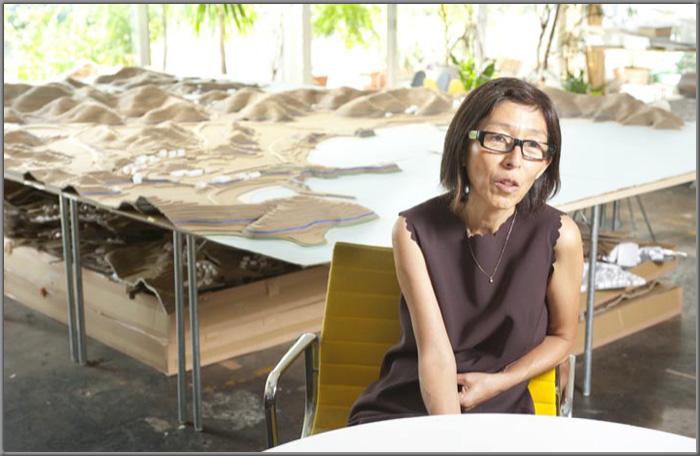Home > Highlighting JAPAN > Highlighting Japan OCTOBER 2011 > Open Architecture for All
Highlighting JAPAN
COVER STORY: Japan’s Women on Top of the World
Caption: Kazuyo Sejima before a model of the reconstruction plan for Miyatojima in Higashimatsushima, Miyagi Prefecture. The model, measuring around 2.5 meters wide and four meters long, was transported to Miyatojima by truck, and then discussed with residents.
Sejima’s office is located along a canal in Tokyo’s Edogawa Ward amid a mixture of high-rise condominiums, housing developments and factories. The office was rebuilt from what was once a warehouse and is one single-storied 740-square-meter space that resembles a gymnasium.
Credit: MASATOSHI SAKAMOTO
Open Architecture for All
Award-winning architect group SANAA (Sejima and Nishizawa and Associates) is inspiring architects and ordinary people around the world with its light, open designs. The Japan Journal’s Osamu Sawaji asked one of the partners in the firm, Kazuyo Sejima, about their work.

Image picture of the entrance hall of Louvre Reims, an extension of the Louvre Museum in the French city of Reims. The museum is scheduled for opening in December 2012.
Credit: IMAGE CYRILLE THOMAS © SANAA / IMREY CULBERT / CATHERINE MOSBACH
CO-CONCEPTEURS : ©KAZUYO SEJIMA + RYUE NISHIZAWA / SANAA, TIM CULBERT + CELIA IMREY / IMREY CULBERT, CATHERINE MOSBACH
The Pritzker Prize jury members recognized SANAA’s architecture for being “simultaneously delicate and powerful, precise and fluid, and ingenious but not overly or overtly clever.”
One piece of architecture that was also recognized by the jury members is the 21st Century Museum of Contemporary Art, Kanazawa in Ishikawa Prefecture. The circular shape of the building with its many glass walls means it has no designations of front or back, and visitors can enter from any of four entrances placed at the north, south, east and west.
“The 21st Century Museum of Contemporary Art, Kanazawa is a good example of an ‘open building.’ The building is open to the surrounding town and we made it so that people can enter smoothly,” says Sejima. “And while the building itself is complete, the impression the museum gives varies wildly depending on how the works inside are displayed.”
SANAA is currently in charge of the design for the Louvre Reims, an extension of the Louvre Museum in the French city of Reims which is scheduled for opening in December 2012. This Museum will also be characteristic of SANAA’s architecture. The buildings will all be low-rise and the entrance hall will be a public space that anyone can enter. In addition, the aluminum outer walls of the exhibition building with their mirrored surfaces will reflect the trees and lawns, helping the building to blend in with the natural surroundings.
SANAA is also working on projects such as the development of La Samaritaine, an established department store in Paris, and on public housing complexes in Paris. In addition, SANAA is proceeding with construction plans for the likes of museums, concert halls and office buildings in Germany, China, South Korea, Mexico and the United States. As a consequence, Sejima has gone on more than twenty overseas business trips a year. While some forty staff work at SANAA’s offices, a quarter of them are foreigners from countries such as Ireland, Italy, France, and the United States. Sejima attracts many overseas architects who have been inspired by her architecture.
“For example, architects in Europe and the United States create extremely thick doors and try to separate the inside and outside of buildings, while Japanese architects use light doors that can be easily opened and closed to preserve the relationship between the inside and the outside,” explains Sejima. “Even for Europe and the United States, I think the fact that they try to incorporate these kinds of Japanese sensibilities in their architecture is one of the reasons I get invitations from overseas.”
In the midst of an increasing number of overseas projects, one local project that Sejima is passionately working on is reconstruction support for Miyatojima island in Higashimatsushima, Miyagi Prefecture, which suffered tsunami damage as a result of the Great East Japan Earthquake. To date Sejima has visited the island several times to proceed a reconstruction plan in consultation with the local residents.
“When you talk with the residents, you realize that even though the town has been lost in a physical sense, it remains firmly rooted in their hearts,” recounts Sejima. “I want it to become a beautiful town in which the lives of people linked with the sea form a part of the scenery.”
© 2009 Cabinet Office, Government of Japan






